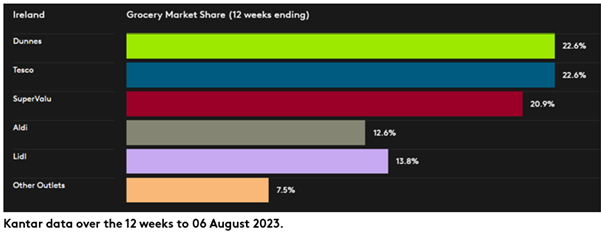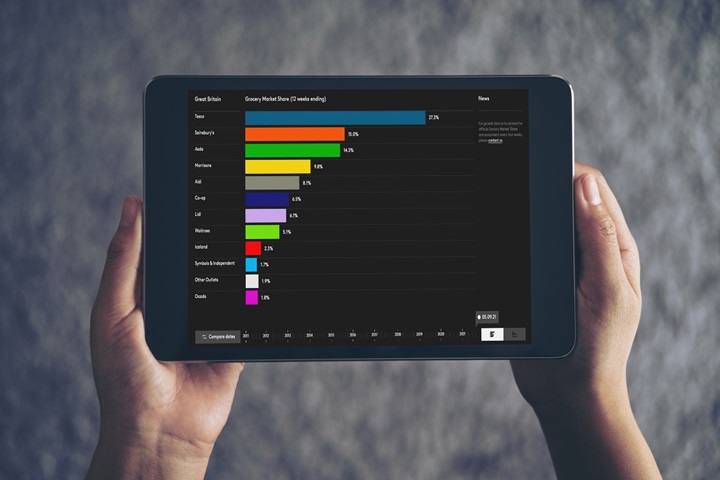Take-home grocery sales in Ireland increased by 6.8% in the four weeks to 6 August 2023 as the average price per pack soared 8.8%, according to our latest data. Compared to last year, shoppers were in the store more often during August, up by 2.7%. However, there was a slight drop in frequency of trips month-on-month, down by 0.5%, from 20.1 shopping trips in July to 19.6 in August.
Grocery price inflation is the driving factor behind the uptick in sales rather than increased purchasing. However, while grocery inflation rose by 12.8% in the 12 weeks to 6 August, it was down on last month and is the lowest level since November 2022.
This is the third month in a row where there has been a drop in grocery inflation, which is welcome news for Irish consumers, although the rate is still incredibly high. Compared to last month’s grocery inflation rate of 14.7% there has been a significant drop of 1.9 percentage points. This is the lowest level we have seen over the past 10 months, and we expect to see a continued gradual decline in inflation rates over the coming months.
The good news is that the slowdown in grocery inflation is starting to come through in prices on the shelf. Compared to May 2023, when grocery inflation hit its highest peak of 16.5%, we are starting to see a slight decline in average prices on essential lines. As a result, we are spending €0.36 less on butter, milk and cheese combined.
The percentage of packs sold on promotion declined by 2.8 percentage points versus 2020, while the percentage of sales sold on promotion stands at 24.8% which is down slightly on last year 0.2 percentage points. With fewer items on promotion, Irish shoppers are looking out for the best deals in the market.
Own label goods remain popular, with sales up 13% in the last 12 weeks, compared to brands at 5.7%. For the third consecutive month, own label retains a higher share of the market than brands, hitting a value share of 48.1% compared to branded share at 46.3%.
Buying own label lines is one of the ways in which Irish consumers have been trying to save money at the tills and we can see the impact of this on their spend. The average increase in the household weekly grocery shop is €9.10 compared to last year, well below the extra €17.80 shoppers would have paid if they bought the same items 12 months ago based on the current rate of inflation.
Summer celebrations dampened due to unseasonal weather
Hopes of a sunny July were dampened with widespread downpours across Ireland impacting sales of the usual summer favourites. Barbeques were kept under wraps as Irish shoppers spent €493k less on chilled burgers & grills and €1.3m less on chilled prepared salads year-on-year. With no need for a summer cool down, shoppers also spent €2.5m less on ice cream and a combined €2.3m less on fruit squash and mineral water.
With Irish consumers spending more time indoors, sales of take-home confectionery and take-home savouries rose €4.7m and €2.6m respectively. Unseasonal weather also meant consumers looked for ‘warmers’, spending an additional €2.8m on soup and hot beverages. Cooler temperatures and a wetter than average month may have also put people off from venturing the shops. Footfall was down for the fifth month in a row with people making 882,000 fewer trips than last month.
Online sales remained strong over the 12-week period, up 11.2% year-on-year, with shoppers spending an additional €16.6m online, a significant boost when compared with last month’s 6% increase (€9m). More frequent trips online boosted performance by 12.6%.
Irish retailer performance update
Dunnes, Tesco and Lidl all grew ahead of the total market in terms of value this month. The gap between the top three retailers continues too close with Tesco and Dunnes holding the combined highest share.
Dunnes holds 22.6% with growth of 12.7% year-on-year. This growth stems from shoppers returning to store more often, up 4.2% year-on-year, along with recruiting new shoppers to store, up 1.3 percentage points.
Tesco also holds 22.6% of the market with growth of 12.6% year-on-year. Tesco had the strongest frequency growth amongst all retailers again, up 16.9% year-on-year, contributing an additional €98.8m to overall performance.
SuperValu holds 20.9% of the market with growth of 5.8%. SuperValu shoppers make the most trips in store when compared to all retailers, 22.2 trips on average, which is up 5.8% year-on-year.
Lidl holds 13.8% share with growth of 12.7% year-on-year. More frequent trips contributed to an additional €40.9m to overall performance. Aldi holds 12.6% with growth of 7.7% year-on-year thanks to a strong boost in new shoppers and more frequent trips, contributing an additional €34.6m to overall performance.



